Denver, CO
Wildfires encroach on homes near Denver as heat hinders fight

A wildfire on the edge of metro Denver crept within a quarter-mile of evacuated homes, but authorities said Thursday morning they were hopeful to save hundreds of threatened residences as they grapple with sweltering temperatures and firefighters suffering heat exhaustion.
The fire was among several threatening heavily populated areas of the Colorado foothills, including one in which a person was killed earlier this week.
Almost 100 large fires are burning across the western U.S. The largest—Northern California’s Park Fire—has burned more than 400 houses and other structures, officials reported Thursday.
New large fires were reported in Idaho, southeast Montana and north Texas.
The Quarry Fire southwest of the Denver suburb of Littleton encroached on several large subdivisions. Neighborhoods with nearly 600 homes were ordered to evacuate after the fire of unknown origin spread quickly overnight Tuesday.
The fire had been held to less than a half-square mile (1.4 square kilometers) with no houses yet destroyed, authorities said. But officials said it remained a major danger with hot temperatures expected Thursday.
Five firefighters were injured Wednesday, including four who had heat exhaustion, said Mark Techmeyer with the Jefferson County Sheriff’s Office.
Just to the north near the city of Lyons, Colorado, officials reported making progress on the Stone Canyon Fire that has killed one person and destroyed five houses. The cause is under investigation.
-
Onlookers gather at a roadblock to watch as a wildfire burns in the mountains near the Ken Caryl Ranch development Wednesday, July 31, 2024, southwest of Littleton, Colo. Credit: AP Photo/David Zalubowski
-
Helicopter heads toward a ridge to make a water drop on a wildland fire burning near the Ken Caryl Ranch development Wednesday, July 31, 2024, southwest of Littleton, Colo. Credit: AP Photo/David Zalubowski
-
Onlookers gather at a roadblock to watch as a wildfire burns in the mountains near the Ken Caryl Ranch development Wednesday, July 31, 2024, southwest of Littleton, Colo. Credit: AP Photo/David Zalubowski
-
Flames rise amid billowing clouds of smoke as a wildland fire burns over ridges near the Ken Caryl Ranch development, Wednesday, July 31, 2024, southwest of Littleton, Colo. Credit: AP Photo/David Zalubowski
California’s Park Fire continued to grow, covering about 610 square miles (1,590 square kilometers) as of Thursday morning. That’s more than 25 times the size of New York’s Manhattan Island.
Losses also increased. The latest updates tallied 437 structures destroyed and 42 damaged, according to Cal Fire. The fire was 18% contained.
© 2024 The Associated Press. All rights reserved. This material may not be published, broadcast, rewritten or redistributed without permission.
Citation:
Wildfires encroach on homes near Denver as heat hinders fight (2024, August 1)
retrieved 1 August 2024
from https://phys.org/news/2024-08-wildfires-encroach-homes-denver-hinders.html
This document is subject to copyright. Apart from any fair dealing for the purpose of private study or research, no
part may be reproduced without the written permission. The content is provided for information purposes only.

Denver, CO
Suspects sought in Denver shooting that killed teen, wounded 3 others

Denver police are searching for suspects in a Saturday night parking lot shooting that killed a 16-year-old and wounded three men, at least one of whom is not expected to survive, according to the agency.
Officers responded to the shooting in the 10100 block of East Hampden Avenue about 10:30 p.m. Saturday, near where East Hampden intersects South Galena Street, according to an alert from the Denver Police Department.
Police said a group of people had gathered in a parking lot on the edge of the city’s Kennedy neighborhood to celebrate the U.S. capture of Venezuelan President Nicolás Maduro when the shooting happened.
Paramedics took one victim to a hospital, and two others were taken to the hospital in private vehicles, police said. A fourth victim, identified by police as 16-year-old William Rodriguez Salas, was dropped off near Iliff Avenue and South Havana Street, where he died from his wounds.
At least one of the three victims taken to hospitals — a 26-year-old man, a 29-year-old man and a 33-year-old man — is not expected to survive, police said Tuesday. One man was in critical condition Sunday night, one was in serious condition and one was treated for a graze wound and released.
No suspects had been identified publicly or arrested as of Tuesday afternoon.
Anyone with information on the shooting is asked to contact Metro Denver Crime Stoppers at 720-913-7867. Tipsters can remain anonymous and may be eligible for a cash reward.
This is a developing story and may be updated.
Sign up to get crime news sent straight to your inbox each day.
Denver, CO
Denver’s flavored vape ban sends customers across city lines

The new year in Colorado brought new restrictions for people who vape in Denver. As of January 1, a voter-approved ban on flavored nicotine products is now in effect in Denver, prohibiting the sale of flavored e-cigarettes and vaping products within city limits.
Just outside the Denver border, vape shops say they’re already feeling the ripple effects.
At Tokerz Head Shop in Aurora, located about a block and a half from the Denver city line, owner Gordon McMillon says customers are beginning to trickle in from Denver.
“I was in shock it passed, to be honest,” McMillon said. “Just because of how many people vape in Denver. But we’re hoping to take care of everybody that doesn’t get their needs met over there anymore.”
One of those customers is Justin Morrison, who lives in the Denver area and vapes daily. He stopped by the Aurora shop a day after the ban went into place.
Morrison says the ban won’t stop him from vaping. It will just change where he buys his products.
“I’m going to have to come all the way to Aurora to get them,” he said. “It’s pretty inconvenient. I smoke flavored vapes every day.”
The goal of the ban, according to public health advocates, is to reduce youth vaping.
Morrison said flavored vapes helped him quit smoking cigarettes, an argument frequently raised by adult users and vape retailers who oppose flavor bans.
“It helped tremendously,” he said. “I stopped liking the flavor of cigarettes. The taste was nasty, the smell was nasty. I switched all the way over to vapes, and it helped me stop smoking cigarettes completely.”
McMillon worries bans like Denver’s could push some former smokers back to cigarettes.
“If they can’t get their vapes, some will go back to cigarettes, for sure,” he said. “I’ve asked people myself, and it’s about 50-50.”
While McMillon acknowledges it will bring more business to shops outside Denver, he says the ban wasn’t something he wanted.
“Even if it helps me over here in Aurora, I’m against it,” he said. “I feel like adults should have the rights if they want to vape or not.”
More than 500 retailers in Denver removed their flavored products. For many, they accounted for the majority of their sales. Denver’s Department of Public Health and Environment says it will begin issuing fines and suspensions to retailers found selling flavored tobacco products.
Both McMillan and Morrison say they’re concerned the ban could spread to other cities. For now, Aurora vape shops remain legal alternatives for Denver customers.
Despite the added drive, Morrison says quitting isn’t on the table.
“It’s an addiction. You’re going to find a way to get it. That’s why I don’t see the point of banning it here,” Morrison said.
Denver, CO
Planning to begin in Denver for American Indian Cultural Embassy

Denver will be the site of the United States’ first-ever American Indian Cultural Embassy.
Funding for the project was approved by Denver voters in the Vibrant Denver Bond measure.
The vision is for the embassy to welcome Native people back home to Colorado.
On the snowy day of CBS News Colorado’s visit, Rick Williams observed the buffalo herd at the Rocky Mountain Arsenal National Wildlife Refuge.
“These animals are sacred to us,” said Williams, who is Oglala Lakota and Cheyenne. “This was our economy. They provided everything we needed to live a wonderful lifestyle.”
Williams is president of People of the Sacred Land and a leader in the effort to build an American Indian Cultural Embassy.
“‘Homeland’ is a special term for everybody, right?” Williams asked. “But for people who were alienated, for American Indians who were alienated from Colorado, they don’t have a home, they don’t have a home community that you can go to, this is it. And I think that’s sad.”
The First Creek Open Space — near 56th and Peña, near the southeast corner of the Arsenal — is owned by the City and County of Denver and is being considered for development of the embassy.
“To have a space that’s an embassy that would be government-to-government relations on neutral space,” said Denver City Councilmember Stacie Gilmore, who represents northeast Denver District 11. “But then also supporting the community’s economic development and their cultural preservation.”
Gilmore said $20 million from the Vibrant Denver Bond will support the design and construction of the center to support Indigenous trade, arts, and education.
“That sense of connection and that sense of place and having a site is so important if you’re going to welcome people back home,” added Gilmore.
“What a great treasure for people in Colorado,” Williams said as he read the interpretive sign at the wildlife refuge.
He said the proposed location makes perfect sense: “Near the metropolitan area, but not necessarily in the metropolitan area, we would love to be near buffalo. We would love to be in an area where there’s opportunities for access to the airport.”
The Denver March Powwow could one day be held at the embassy.
Williams dreams of expanding the buffalo herd nearby and having the embassy teach future generations Indigenous skills and culture.
The concept for the embassy is one of the recommendations emerging from the Truth, Restoration, and Education Commission, a group of American Indian leaders in Colorado who began to organize four years ago to study the history of Native Americans in our state.
And the work is just beginning.
“We have to think about, ‘how do we maintain sustainability and perpetuity of a facility like this?’” Williams said. “So there’s lots of issues that are going to be worked on over the next year or so.”
Williams added, “One day our dreams are going to come true, and those tribes are going to come, and we’re going to have a big celebration out here. We’re going to have a drum, and we’re going to sing honor songs, and we’re going to have just the best time ever welcoming these people back to their homeland.”
Denver Mayor Mike Johnston’s staff sent the following statement:
“We are excited about the passing of the Vibrant Denver Bond and the opportunity it creates to invest in our city’s first American Indian Cultural Embassy. We are committed to working hand-in-hand with the Indigenous community to plan and develop the future embassy, and city staff have already been invited to listen and engage with some of our local American Indian groups, like the People of the Sacred Land. We are not yet at the stage of formal plans, but we are excited to see the momentum of this project continue.”
-

 World1 week ago
World1 week agoHamas builds new terror regime in Gaza, recruiting teens amid problematic election
-

 News1 week ago
News1 week agoFor those who help the poor, 2025 goes down as a year of chaos
-

 Business1 week ago
Business1 week agoInstacart ends AI pricing test that charged shoppers different prices for the same items
-

 Health1 week ago
Health1 week agoDid holiday stress wreak havoc on your gut? Doctors say 6 simple tips can help
-

 Technology1 week ago
Technology1 week agoChatGPT’s GPT-5.2 is here, and it feels rushed
-

 Business1 week ago
Business1 week agoA tale of two Ralphs — Lauren and the supermarket — shows the reality of a K-shaped economy
-

 Science1 week ago
Science1 week agoWe Asked for Environmental Fixes in Your State. You Sent In Thousands.
-

 Politics1 week ago
Politics1 week agoThe biggest losers of 2025: Who fell flat as the year closed




















